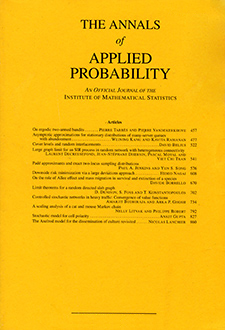Abstract
The stepping-stone model is widely used in population genetics to describe the evolution of a population with mating and geographical structure. It is typically formulated on a countable set, where each element of the set corresponds to a colony. Each colony consists of a population of a fixed number of haploid individuals. Individuals undergo random mating within each colony and migrate to neighboring colonies. In the model considered here, we are interested in the changes that may occur at a single locus on a single chromosome at which two alleles are possible. Changes in the gene frequencies are caused by migration between colonies, in addition to mutation, selection and random mating within each colony. It is frequently assumed that local populations persist indefinitely. This, however, is a reasonable assumption only if the average time until extinction of a local population is much larger than the time interval over which the whole population is studied. In this paper, using the framework of interacting particle systems, we address the question of how extinction and recolonization affect the spatial distribution of gene frequencies in both homogeneous and inhomogeneous environments. It turns out that extinction does not change the qualitative behavior of the model in a homogeneous environment; that is, in one and two dimensions, the population clusters in the absence of mutation (i.e., it consolidates into larger and larger blocks), whereas in higher dimensions, coexistence is possible. However, there are quantitative differences. For example, we find that extinction speeds up clustering in one dimension. In inhomogeneous environments, extinction can drastically change the behavior and new phenomena, such as coexistence in $d = 2$, appear.
Citation
Hyun-Chung Kang. Stephen M. Krone. Claudia Neuhauser. "Stepping-Stone Models with Extinction and Recolonization." Ann. Appl. Probab. 5 (4) 1025 - 1060, November, 1995. https://doi.org/10.1214/aoap/1177004605
Information





